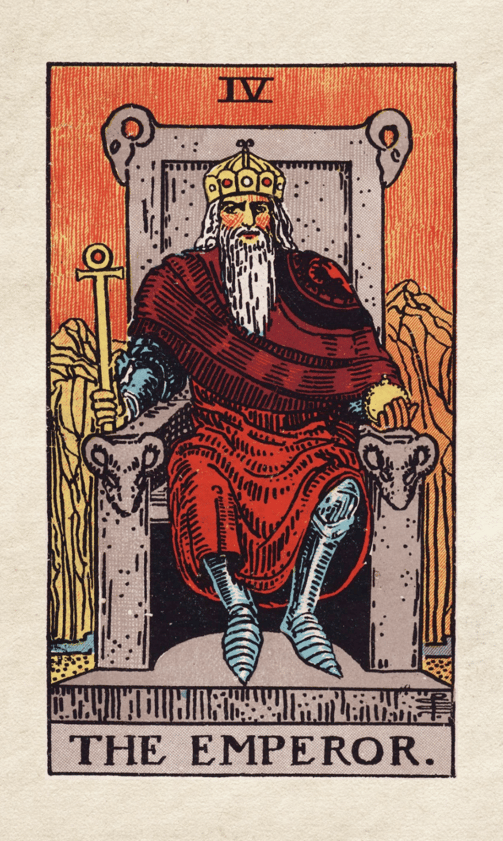The Fool Meets The Emperor:
A Lesson in Structure, Authority, and Leadership
The Emperor "teachings are clear: in order to grow, The Fool must learn to take charge of his own life, embrace responsibility, and create structure to support his goals."


After learning the nurturing wisdom of The Empress, The Fool continues his journey, filled with creative inspiration and a sense of harmony with the natural world. As he moves forward, he encounters another guide—The Emperor—a figure of authority, discipline, and order. Where The Empress ruled through love and nurturing, The Emperor governs with structure, logic, and stability.
The Emperor: The Archetype of Authority and Leadership
The Emperor is often depicted sitting on a solid stone throne, symbolizing his firm control over his domain. He wears armor beneath his robes, suggesting that while he is a ruler of reason and order, he is also a protector. The Emperor holds a scepter, representing his authority and power, and his stern gaze reflects the seriousness with which he upholds his responsibilities.
He governs with a strong hand, ensuring that there is structure and security. While The Empress embodies the creative flow of nature, The Emperor brings the balance of structure, showing The Fool that boundaries and rules are necessary to create stability in life.
Key Characteristics of The Emperor:
-Authority and Power: The Emperor represents leadership and authority. He teaches The Fool the importance of self-discipline and taking control over one’s life.
-Structure and Order: Where The Empress allowed for growth and creativity, The Emperor focuses on creating structure. He shows The Fool that boundaries, rules, and organization are necessary for success and personal growth.
-Protection and Security: The Emperor, as the father figure, is a protector. He ensures that his kingdom is safe and secure, teaching The Fool the value of taking responsibility for those he leads or cares for.
-Logic and Reason: Unlike the emotional and intuitive energies of The Empress and High Priestess, The Emperor governs through logic and clear thinking. He teaches The Fool to rely on strategy and careful planning when facing challenges.
Key Characteristics of The Emperor:
-Authority and Power: The Emperor represents leadership and authority. He teaches The Fool the importance of self-discipline and taking control over one’s life.
-Structure and Order: Where The Empress allowed for growth and creativity, The Emperor focuses on creating structure. He shows The Fool that boundaries, rules, and organization are necessary for success and personal growth.
-Protection and Security: The Emperor, as the father figure, is a protector. He ensures that his kingdom is safe and secure, teaching The Fool the value of taking responsibility for those he leads or cares for.
-Logic and Reason: Unlike the emotional and intuitive energies of The Empress and High Priestess, The Emperor governs through logic and clear thinking. He teaches The Fool to rely on strategy and careful planning when facing challenges.
The Lesson: Embracing Leadership and Responsibility
The Fool, with his carefree and curious nature, is both fascinated and slightly intimidated by The Emperor’s commanding presence. However, The Emperor’s teachings are clear: in order to grow, The Fool must learn to take charge of his own life, embrace responsibility, and create structure to support his goals.
The Emperor’s Teachings:
-Take Control of Your Life: The Emperor teaches The Fool that while creativity and intuition are essential, he must also take responsibility for his actions and decisions. Leadership begins with self-discipline.
-Create Structure: The Fool learns from The Emperor that setting boundaries and creating routines are vital to maintaining stability and focus. Without structure, chaos can ensue, making it difficult to achieve goals.
-Use Logic and Strategy: The Emperor emphasizes the importance of clear thinking. When challenges arise, The Fool must learn to approach them with a logical mind, planning carefully rather than relying solely on impulse.
-Lead with Strength and Compassion: The Emperor is not just a ruler but a protector. The Fool learns that true leadership involves caring for and protecting others while also being firm and just.
Applying The Emperor’s Wisdom in Daily Life
-Establish Routines: Incorporate structure into your daily life by creating routines that support your goals. Whether it’s a morning ritual, a work schedule, or a fitness plan, having a structure in place can help you stay focused and organized.
-Set Boundaries: Learn to set healthy boundaries in your relationships and personal life. Boundaries help protect your time, energy, and emotional well-being.
-Plan Strategically: When faced with a decision or challenge, approach it with a clear plan. Break down your goals into actionable steps, and rely on logic and strategy to guide you.
-Embrace Responsibility: Whether in your personal or professional life, take ownership of your actions. Be a leader, not only to others but in how you manage yourself.
Conclusion: The Fool’s Journey Toward Mastery
The encounter with The Emperor is a turning point for The Fool. While previous guides like The Magician and The Empress focused on creativity, intuition, and nurturing energy, The Emperor introduces the concept of responsibility, structure, and leadership. He teaches The Fool that success and personal growth require a balance of creativity and discipline.


